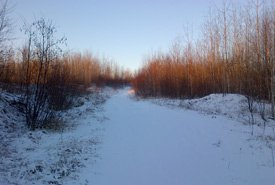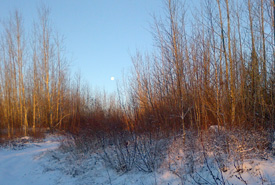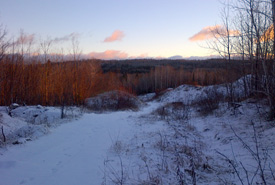After the clear-cut: A tale of resilience

Sun rising over the aspen forest (Photo by Emma Christensen)
When I think “clear-cut,” I automatically think habitat loss. I don’t think I’m alone in this. Pictures of ravaged swaths of cleared forest, punctuated by the upturned root systems of old-growth conifers, have been commonplace in the media for decades. But skiing regularly through a former clear-cut area near my home, where tracks and scat from hare, fox, lynx, deer and moose assured me that they too are regular visitors to the aspen stand, has made me profoundly aware of something else: a forest’s ability to regenerate after destruction.
In the wake of logging of the forest near my home 15 or 20 years ago, aspen saplings have sprung up. The young trees are the start of a new forest. And, early in their life cycle, the trees serve as a source of food and shelter for wildlife.

Young trees comprise this aspen forest (Photo by Emma Christensen)
Aspen trees are able to regenerate successfully because they employ a running root system to produce clones — trees that are genetically identical. These species also produce a number of tiny seeds that are dispersed by the wind. The USDA Forest Service calls aspen an “aggressive pioneer species” because it regrows rapidly in the full sun conditions left behind by fires or logging. Unaffected by growth-inhibiting hormones produced by mature aspens, young trees in a clear-cut are free to proliferate. When an aspen dies or there is an increase in light, chemical signals from the tree to its roots stimulate new sprouts to grow.
Unfortunately, these trees that are so quick to regenerate are also quick to die. While these individuals may die, they often reproduce a clone tree that can live for thousands of years. A Cut Above, a documentary produced by the Wildlands League, emphasizes that aspen stands are poor substitutes for the diverse mature forests that stood there before the logging.
There are stands of aspen that are very old. In some cases they self-replicate (especially in western provinces, such as British Columbia). In southern Canada and the boreal region, the young forest often has aspen and conifers, but the aspens initially grow faster. Eventually the conifers take over and it reverts back to a coniferous forest.

The forest is slowly but surely making its way back to what once stood before. (Photo by Emma Christensen)
Maintaining variety seems to be the secret to harvesting and regenerating healthy forests. Using a range of timber harvesting techniques — including clear-cutting, which can mimic fire — and conserving an array of habitat types ensure that the needs of both the timber industry and wildlife are met.
We might not be ready to rethink timber harvest and regeneration — doing so would demand time, money and a commitment to adjusting our current forest management practices — but nature isn’t waiting around for us. We need young and old forests in order to keep habitat diversity in Canada.
Constant movement, growth and change greet me every time I ski through the aspen stand. The young forest — and the animal species within it — never seem to stop adapting and making adjustments. For the health of our forests, we’d be wise to do the same.


